Here’s a video of a female Magicicada septendecula found in Woodbridge Township, NJ (near Metro Park).
Here is a still photo:
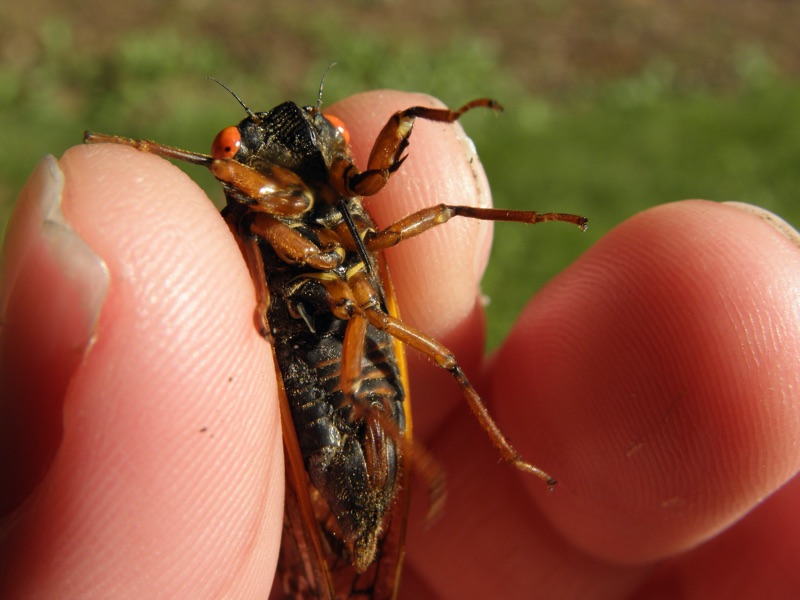
This is a male Magicicada septendecula:
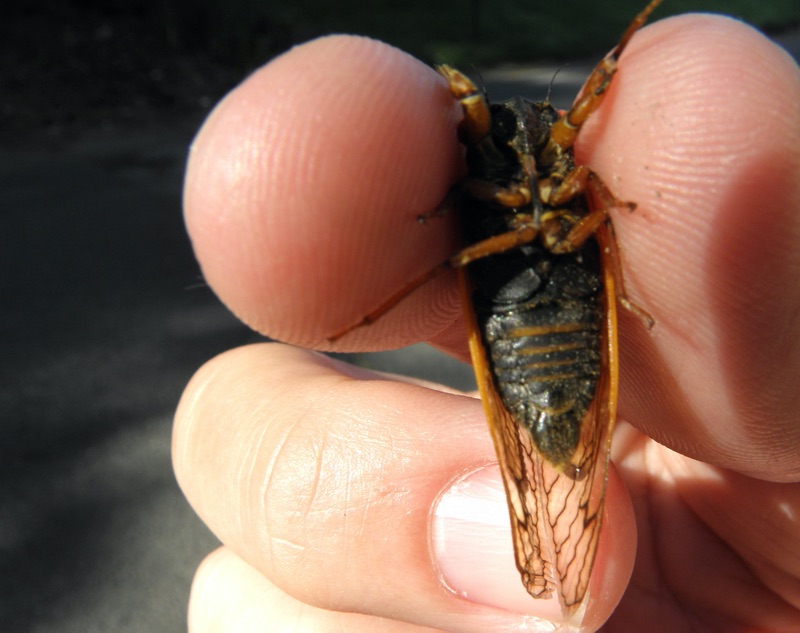
Here’s a video of a female Magicicada septendecula found in Woodbridge Township, NJ (near Metro Park).
Here is a still photo:

This is a male Magicicada septendecula:

I didn’t see any nymphs emerge and undergo ecdysis tonight, but I did find plenty of cicada chimneys and nymphs trapped under slates.
Cicadas build chimneys above their holes, typically after it rains a lot and the soil becomes soft. The chimneys help keep water from rushing into their holes, and they keep ants and other menaces out.
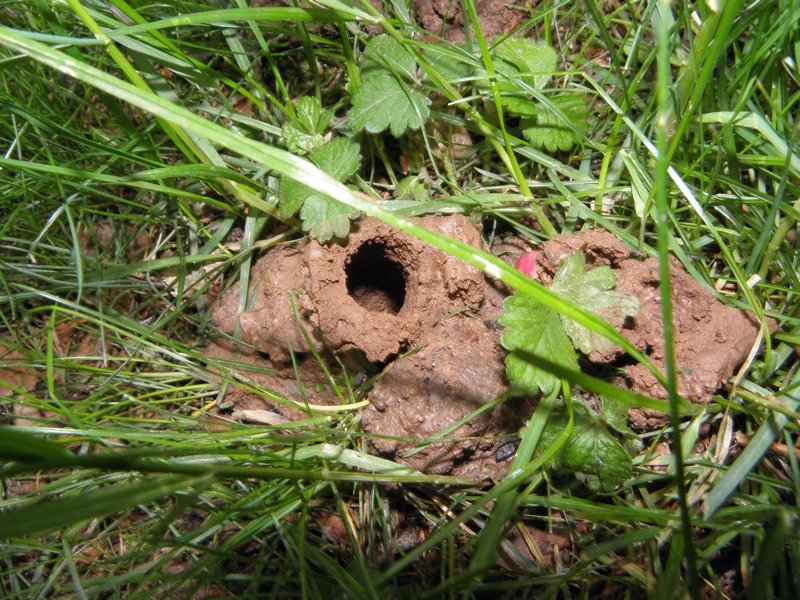
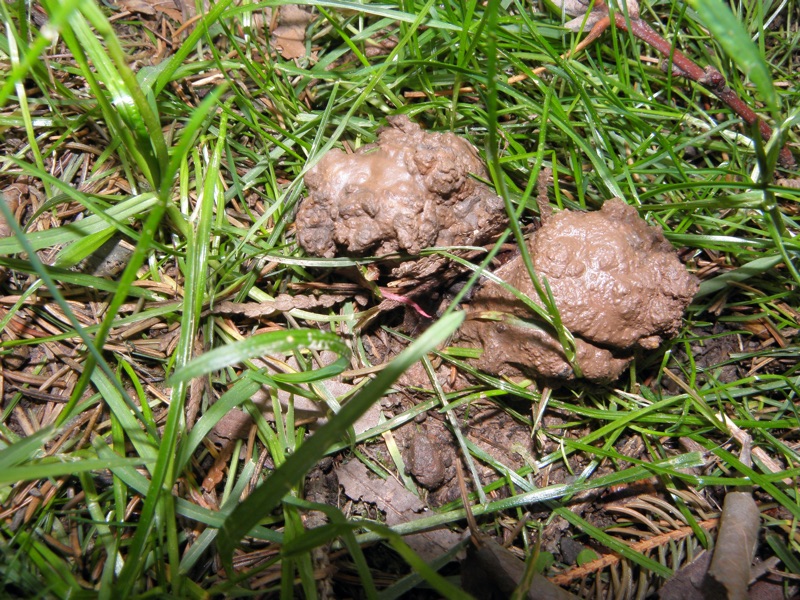
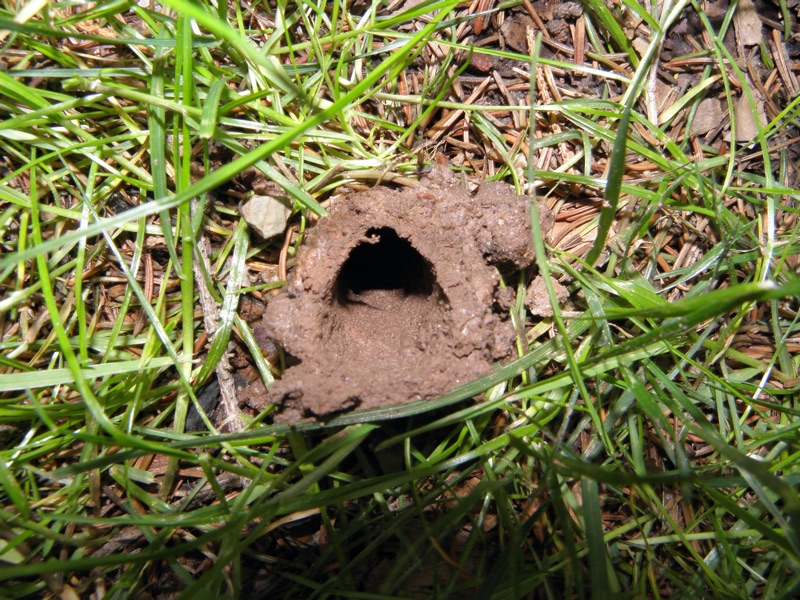
A good place to find cicada nymphs is under backyard slates (or similar objects that cover the ground). Flip over your slates and you might find a nymph tunneling their ways to the side of the slate.
Brood II 17 Year Cicada Nymph trapped under a slate from Cicada Mania on Vimeo.
When a cicada sheds its nymphal skin, revealing its adult form, we call it ecdysis. You probably call it molting, and that’s just fine.
Here are a bunch of videos of cicadas moulting:
Here is a Magicicada nymph molting (the 17-year variety) by Roy Troutman:
Magicicada nymph molting from Roy Troutman on Vimeo.
Annual cicada molting to an adult by Roy:
Annual cicada molting to an adult from Roy Troutman on Vimeo.
Here is Tibicen moulting by blackpawphoto (YouTube Link):
Here is a video of a Japanese cicada, the Terpnosia nigricosta, moulting by AntoSan09 (YouTube Link):
I received a pair of ceramic singing cicadas for Christmas. Here’s a video of what they look and sound like. They are made in France and were obtained from a restaurant in Westfield, NJ called Chez Catherine.
Cicadas are called cigale in France.
Here’s the cicada Keychain mentioned in the video.
The trees near where I work are chocked full of Tibicen tibicen cicadas (formerly known as T. chloromera, also known as Swamp cicadas).
Here is a short video featuring the call of a Tibicen tibicen that I recorded this morning:
Here’s a sound file of the cicada’s song…
If you’re in North America in mid to late summer, you might notice an abundance of large black and yellow wasps flying around your yard or local park. If you’re lucky enough, you’ll spot one of these wasps with a chubby green, black & white Tibicen cicada in its grasp.
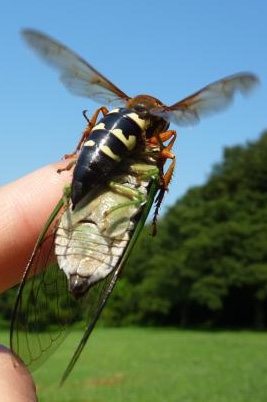
These wasps are appropriately named Cicada Killer Wasps. There are many species of Cicada Killer Wasps, but the most well known is the Eastern Cicada Killer Wasp (Sphecius speciosus). These wasps paralyze and bring the cicadas to their burrow, where the cicada is used as food for a Cicada Killer Wasp larvae. The best Cicada Killer Wasp resource on the web is Prof. Chuck Holliday’s Biology of cicada killer wasps. If you’re interested in these wasps, visit Prof. Holiday’s site now.
People fear these wasps because they are large and we tend to fear stinging insects, but truthfully these wasps are not interested in stinging people — they are interested in stinging cicadas. Unlike more aggressive species of stinging insects, Cicada Killer Wasps will probably only sting you if you step on, harass or otherwise physically contact the creature. If you don’t want to be stung, don’t harass the wasps. Not need to panic. No need to bomb your local environment with pesticides.
Take a look at this stunning picture of a Cicada Killer Wasp holding a cicada while perched on Elias Bonaros’ finger. Neither Elias or the wasp was harmed. The cicada was harmed and likely eaten by a wasp larva.
Update:
Elias recorded this footage of a Cicada Killer “mating ball”. If you weren’t terrified by the image of the Cicada Killer clutching the Tibicen on Elias’ finger wasn’t scary enough, check this out:
Cicada Killer from Cicada Mania on Vimeo.
Folks who have followed this website for the past 16 years (there are a few who have) know about the Lucky Cicada Keychain, and how I’ve been looking for a working model for the past 16 or so years. I finally have one now. I had to pry it open and replace the batteries (should have used a 192, but I used a 392 instead), but it works. Here’s a video so you can see what it looks and sounds like.
Thee Legendary Lucky Cicada Keychain from Cicada Mania on Vimeo.
Here are six cicada projects and experiments you can try during the coming Brood XIX 13-year periodical cicada emergence in America.
White eyed Magicicada by Dan from Cicada Mania on Vimeo.
(Magicicada only)
White or Blue eyed Magicicada are very rare! Typically they have red or orange eyes. There was even an urban legend that scientists were offering a reward for white-eyed Magicicada (well, that was a legend, until Roy Troutman actually offered a reward in 2008). Aside from Blue or White-eyed Magicicada, you can find other colors like yellow eyes, and multicolored eyes.
Try this: Have a contest amongst your friends and family for who can find the most white, yellow and multicolor-eyed cicadas.
(Magicicada only)
How do you get a male cicada to sing? Imitate a female cicada. Female cicadas don’t sing, but they do click their wings together to get a male cicada’s attention.
Try this: snap your fingers near cicadas almost immediately (half-second) after a Male stops singing. Male cicadas will hear the snap and think it’s a female clicking her wings, and they may sing in response.
You can also try imitating male cicada calls to get the females to click their wings. Magicicada tredecim and Magicicada neotredecim are probably the easiest to imitate with their “Waaah Ooh”/”WeeOoh” calls. You can find sound files on the Cicadas @ UCONN (formerly Magicicada.org) site so you can practice.
(Magicicada only)
One of the best ways to locate cicadas is to simply listen for them. When you’re driving or biking around town, take note of where you hear cicadas. If you hear cicadas in a public place, don’t we afraid to stop and observe them.
Try this: Travel around listening for cicadas, document their location and numbers, and report them to magicicada.org.
Tips:
(Works for most cicadas)
You can observe many phases and activities of a cicada’s life while they are above ground.
Try this: Photograph or film as many stages of a cicada’s life as possible, then create a slideshow or movie depicting the life of a cicada. Post your finished slideshow or movie on the web (YouTube?) so other people can enjoy it.
Phases of a cicadas life you can try to capture:
(Magicicada only)
Cicada researcher Gene Kritsky developed a cicada emergence formula to try to predict when the cicadas will emerge based on the mean temperature in April.
Try this: on May 1st, go to our cicada emergence formula page, follow the instructions and find out when the cicadas might emerge in your area. Document when the cicadas emerge in your area, and compare the results. Note whether the cicadas emerge in sunny or shady areas.
Magicicada nets from Cicada Mania on Vimeo.
(Works for most cicadas)
People ask: “what’s the best way to keep a cicada in captivity?” The answer depends on how long you plan on keeping the cicada, and how happy you want the cicada to be.
Wooden and plastic bug houses (“Bug Bungalows”, “Critter Cabins”, “Bug Jugs”, etc.) will suffice as temporary homes for cicadas. The classic jar with holes punched in the lid works too. Add a fresh branch for them to crawl on and drink fluids from (or at least try). Remember not to leave it in the sun so the cicadas inside don’t bake!
Butterfly Pavilions are collapsible containers made of netting that you can use to gather cicadas, and provide them with a temporary home. People also use Fish Aquariums to keep cicadas in their homes for extended periods of time — add plenty of vegetation for the cicadas to crawl around on and some water for the cicadas to sip.
Try this: get some flexible netting and wrap it around a branch on a tree, making sure not to leave any openings, then put your cicadas inside. Cicadas in this kind of enclosure will be more likely to sing and interact because life trees are their natural habitat.
You can also try wrapping netting around a small, potted maple tree.
Want to keep your cicadas forever? Try the Massachusetts Cicadas guide to preserving cicadas.
I had some free time today so a made a video of the cicada-related objects I’ve collected over the past 15 or so years. The video includes cicada noise makers, whistles, action figures, a music comp, a kite, cicada soda, rubber toys, fishing lures and other fun stuff.
Cicada Toys, Art, Action Figures, Lures, Keyrings, Soda and other Objects from Cicada Mania on Vimeo.
The Brood XIX (and Brood IV stragglers) are all but gone, but annual species of cicadas are emerging around the United States right now. The various annual species of cicadas differ from periodical cicadas in many ways. Annual cicadas emerge in limited numbers every year, they are not organized into broods, they tend to be timid and camouflaged to match their environment, and while their life cycles are longer than a year, they are not as long as 13 or 17 years.
The most common annual cicada east of the Rockies is probably the various species of the Tibicen genus. There are also cicadas belonging to the Diceroprocta, Neocicada, and Okanagana genera out and about now.
Use the Insect Singers website to help match the species to their song.